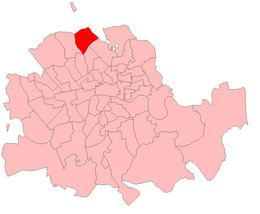Created 1885 European Parliament constituency London Number of members 1 | Electorate 68,777 (December 2010) Replaced by Finsbury | |
 | ||
Islington North /ˈɪzlɪŋtən nɔːθ/ is a constituency created in 1885 represented in the House of Commons of the UK Parliament since 1983 by Jeremy Corbyn of the Labour Party. Corbyn has been Leader of the Labour Party and the Opposition since September 2015.
Contents
Political history
The constituency has at each election since a 1937 by-election elected the Labour Party candidate. The narrowest winner's majority over the runner up in this time excluding the by-election itself was in a by-election in 1969: 10.4% of the vote which showed the seat on a very low turnout to be marginal in majority on its then boundaries, with its contemporary demography and prevailing political context at the time, during the final year of the Second Wilson Ministry.
By contrast the continuous victor since 1983, Jeremy Corbyn, has attained a smallest majority of 15.3% in 1983 and maximum majority of 55.6% in 1997. In four elections during Corbyn's tenure the runner up party has been the Liberal Democrats. The 2015 result made the seat the 26th safest of Labour's 232 seats by percentage of majority.
Proposed abolition
If the 2016 recommendations of the Boundary Commission for England and Wales are approved by Parliament, the constituency will be abolished at the 2020 general election.
1885–1918
The seat was created by the Redistribution of Seats Act 1885, as one of four divisions of the new parliamentary borough of Islington. The constituency was defined in the legislation as consisting of the single ward of Upper Holloway of the parish of Islington. The ward was one of eight used in the election of Islington vestrymen under the Metropolis Management Act 1855.
1918–1950
Under the next redistribution of seats by the Representation of the People Act 1918 constituencies in the County of London were defined in terms of wards of the metropolitan boroughs created in 1900. Islington North comprised three wards of the Metropolitan Borough of Islington: Tollington, Tufnell and Upper Holloway.
1950–1974
At the next redistribution of seats by the Representation of the People Act 1948 the constituency was again defined as Tollington, Tufnell and Upper Holloway wards of the Metropolitan Borough of Islington, with boundaries as they existed at the end of 1947.
1974–1983
In 1965 local government in Greater London was reorganised, with the formation of London boroughs. The changes were reflected in parliamentary boundaries from 1974. The London Borough of Islington was divided into three constituencies. Islington North was defined as comprising seven wards: Highview, Hillmarton, Hillrise, Junction, Parkway, St. George's and Station.
1983–1997
In 1983 the parliamentary representation of Islington was reduced to two constituencies. The new, enlarged, Islington North was formed from ten wards of the borough as they existed in February 1983. These were Gillespie, Highbury, Highview, Hillrise, Junction, Mildmay, Quadrant, St. George's, Sussex and Tollington wards.
1997–2010
In 1997 there were only slight boundary changes, with the constituency defined as the same ten wards with their boundaries as they existed on 1 June 1994.
Since 2010
The seat covers the northern half of the London Borough of Islington, which includes the areas of Holloway, Highbury, Tufnell Park and Archway.
The constituency now comprises eight wards:
Finsbury Park, Highbury East, Highbury West, Hillrise, Junction, Mildmay, St. George's and Tollington.
These boundaries have been considerably changed since 1970, when Islington returned three MPs and shared another with Hackney. This reflects the depopulation of central London on a lowering of adult occupancy of households and the local authority has replaced tower blocks. The core of the constituency was the area north of Seven Sisters Road and Camden Road. At .735 square kilometres (0.284 sq mi), it is the smallest UK Parliamentary constituency. At the Fifth Periodic Review of Westminster constituencies begun in 2012 the seat was approximately 1,300 electors below the electoral quota and the highest concentration of elector density nationally. The criteria of successive reviews emphasise equal electorates as well as restricting seats to one or, if unavoidable, two local authority areas. The criteria feed critiques of entrenched Labour and Conservative "safe seats" which find themselves concentrated within needy and affluent local authorities respectively.
Elections in the 1910s
Further information
Michael O'Halloran, elected Labour MP for Islington North in 1969, was the subject of an investigation in the early 1970s by The Sunday Times newspaper. They highlighted his background with a local building company and the local Irish community and queried the tactics of his supporters during his selection as candidate.
O'Halloran joined the SDP in September 1981, as did both of the other Islington MPs. However the Boundary Commission cut the number of constituencies in Islington from three to two. O'Halloran sought selection as the SDP candidate for the revised Islington North constituency but the local SDP association selected John Grant, then SDP (elected as Labour) MP for Islington Central, as its official candidate. In February 1983, O'Halloran resigned his membership of the SDP and sat in Parliament as an "Independent Labour" member, supporting the Parliamentary Labour Party. Despite this, he failed to regain the Labour Party nomination for the 1983 General Election and he was defeated by the new Labour candidate, Jeremy Corbyn, coming fourth with 11.1% of the vote.
Corbyn defeated Paul Boateng for the Labour Party selection. Boateng subsequently became the first black cabinet minister in the UK.
